Pictures of your child on YouTube, discriminatory statements in comments, nasty jibes in the Messenger group or forbidden symbols: Content on the Internet can cause trouble for many reasons. However, they don’t appear anywhere on the web, but concretely on platforms, apps and websites. And there you can also report this.
Providers try to set rules and monitor them to the extent they can. There are even laws for this, such as the Youth Protection Act. When content is reported, the platform must check within a short time whether it is punishable content and delete it. For this, the platforms depend on the participation and help of the users. Whether on YouTube. WhatsApp, Instagram or TikTok: Everywhere, you or your child can report content that may violate platform policies or a law. For example, reporting racist content has increased dramatically in recent years, according to YouTube and Facebook.
Reviews and comments from other users or parents can also be helpful with apps or games if you are unsure if they are suitable. For example, the app stores often indicate when there are a lot of ads or in-app purchases, or when a game is very violent. If you or your child have had your own experiences, or if content seems suspicious to you, share it with others, taking advantage of this valuable opportunity to support each other.

© photothek.net
As your child reaches adolescence, it becomes increasingly difficult to direct him or her to appropriate media content. Most young people want to distance themselves from the parental home during this time and orient themselves more to their peers and to youth cultures. These also strongly influence interest in and use of media offerings. However, it is still important that you stay in conversation with your child and keep saying that some media content is only allowed from the age of 16 or 18 for reasons of youth protection.
At the same time, try to share media and let your child show you exciting content. The older it gets, the more it also moves on a similar level to you in terms of understanding content, humor or the like.
Children and young people of this age have taken their first steps on the Internet and already know their way around reasonably well. Almost all of them now have their own cell phone or can use one of their parents’ devices. On the one hand, the interests and activities are as diverse as the children themselves; on the other hand, very similar phenomena can be observed. It is becoming increasingly important to use the media to build a world of their own, even without the guidance and supervision of parents. This includes communicating more and more with friends, increasingly unobserved by parents.
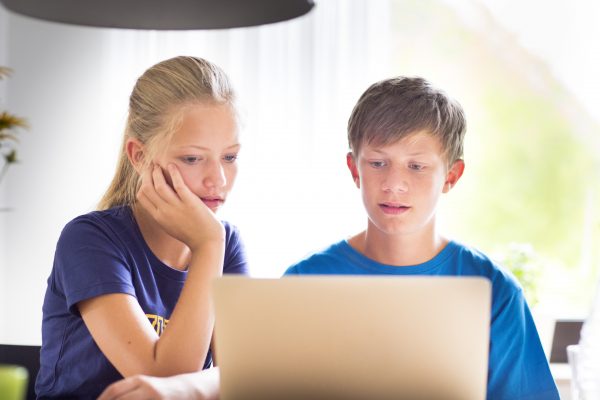
© photothek.net
Interests are further developed online. Children find out about topics of their own choosing, follow celebrities on social media or video platforms, and begin to show themselves off to their peers or even the public via various apps. For some, it is important to play undisturbed alone or with their friends – even online. In the process, they develop their own expertise and skills and live out their creativity.
Children and young people are not yet able to assess very well what it means to put certain data on the Internet, what other risks there are, or how it should be assessed when others misbehave on YouTube and the like. Increasingly, young people are moving away from purely child-friendly media use, going online more often on their own and repeatedly encountering content that can overwhelm them and that they cannot process on their own. In addition to youth media protection, you as parents should still lend a helping hand. Feel free to share your child’s diverse experiences on the web and also support your child’s formation of opinions about them. As parents, you have a particularly important guiding role in this transitional phase, and you should encourage safe use of digital media.
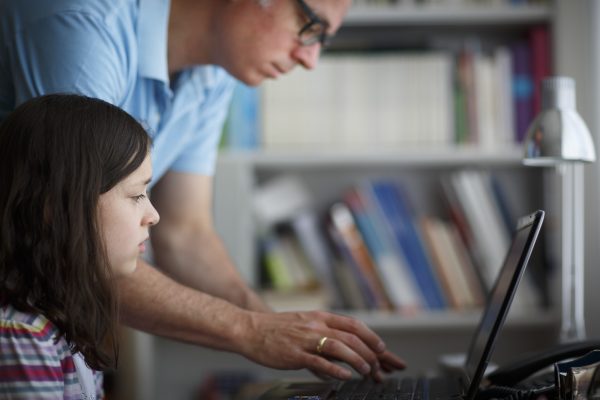
Copyright: Ute Grabowsky/photothek.net
Especially if your son or daughter is already on the Internet on his or her own from time to time, it is important that you as parents are always available to answer questions and solve problems. If possible, you should surf together with your child as often as possible. This will give you a feel for how competently and safely your daughter or son is navigating the web. Over time, your child should also be given the opportunity now and then to discover a topic for himself on selected pages alone and to make his first experiences without parents. If there is an open, relaxed approach to the Internet right from the start, this will be transferred to your child, who will thus be able to encounter challenges without bias and at the same time develop a healthy skepticism.
In the toddler age clearly better symbolic understanding is shown. Toddlers act out their own stories – alone or with peers. Typical of this is the “father-mother-child” game. Such games are important for children’s development: it increases social skills and strengthens, for example, attention, speech, imagination, and later also writing and reading skills. Many child-oriented films and television content take advantage of this: they show fictional worlds that children often act out themselves afterwards.
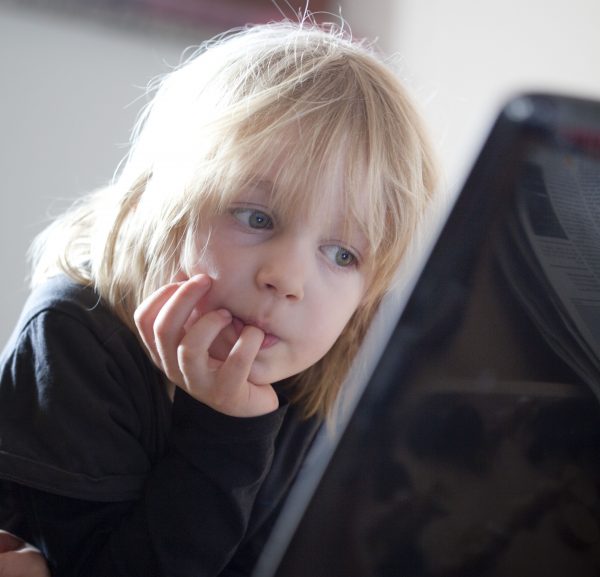
© photothek.net
Media competence also benefits children later, at school age! If children understand media symbols well, they can also learn language and mathematical content more easily in preschool and make better use of learning media.
The Internet, i.e. websites, do not yet play such a large role for preschool children compared to other media activities. The children use media for information about the living environment and for orientation for their own position in friendships and family. Educationally valuable media programs can provide assistance. You should make sure that the programs children use are also age-appropriate and do not teach behaviors that are harmful.
If you want to support your child in using media so that he or she can acquire digital media in a meaningful way, you should consider when this makes sense and what the support might look like. Moving beyond the daily read-aloud book to cinematic sequences or picture stories can be a start.
Apps that have been programmed explicitly for children are particularly suitable as an introduction to online worlds: As a small, self-contained program, they offer clear content. Navigating here also works via finger movement or voice input. At the same time, the childlike preference for repetition is practiced. Be sure to establish rules about usage time and frequency early on. Ideally, you should test the app beforehand and possibly play through it. Find out exactly what apps you install for your child. Important aspects here include advertising and possible in-app purchases. You can also use test reports as a guide.
Good children’s apps are characterized by the following features:
An overview of recommended apps for children is difficult due to the rapid changes on the web. However, you can find help at the German Youth Institute (DJI), at klicktipps or at SIN – Studio im Netz, among others.
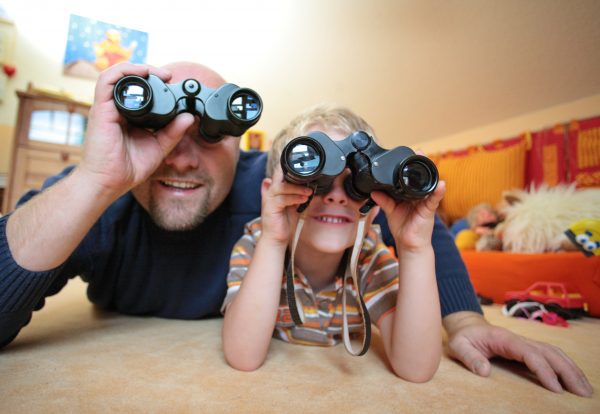
Copyright: U. Grabowsky/photothek.net
Media can inform and entertain. They are meant to bring joy, not fear. Whether it’s video, audio, images, text or games, media comes in many different forms. Children can learn to deal with media in a meaningful way through various offers. This is also possible with computer games. Responsible use of media is important in order to be more protected from dangers on the Internet. Your child can learn this only with your help.
It’s also up to you what media your child uses and how they use it. Help him to do so! Dare to try new media for you, too. If your child has a particular interest in an offering, the best thing you can do is explore and understand that offering with your child.
There is a suitable media offer for almost every concern. Our article ” How can I recognize a good children’s site?” will help you find media content suitable for children. Or take a look at which offerings have received the Educational Media Award in recent years.
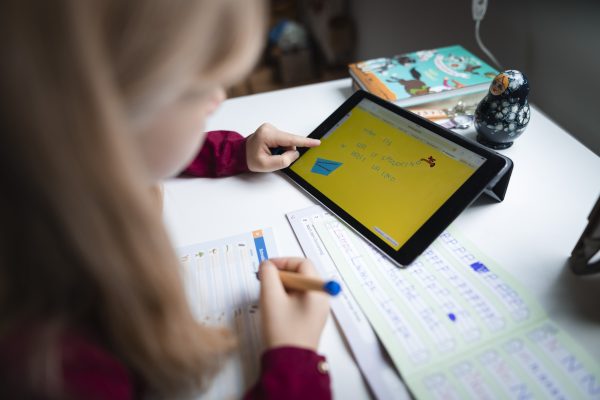
Copyright: photothek.net
Your child is not only looking for entertainment on the web, tablet and laptop are not just for passing time. Children and young people also use media specifically for learning and information – whether on behalf of the school or out of their own interest. If your child feels you don’t believe him when he learns with the tablet, it will lead to frustration. The fact that digital media are so fascinating opens up the opportunity to combine learning and fun. You should support this!
Especially in secondary school, it is becoming natural for children and young people to use digital media for school: They do research for lectures or create a presentation on a laptop. Your child may also be using an online tutoring service.
Your child learns that digital media are not just for entertainment and communication, and acquires important skills that he or she will probably need later in his or her career.
Young people are more than just consumers of media. They are actively shaping it as you can see on platforms like YouTube or TikTok. Not only do people watch videos here, they often publish their own. Well-known YouTubers and influencers have all started small and built up a million-fold audience over the years.
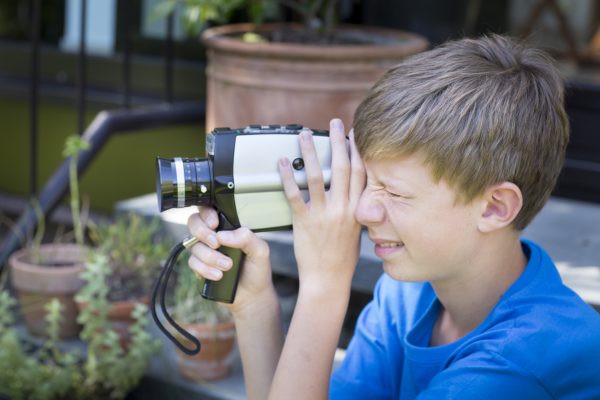
Copyright: Ute Grabowsky/photothek.net
The topics on which videos are published are very diverse. Many people talk about their own everyday life in so-called vlogs. A lot of videos are about cosmetics and fashion; many make funny videos and others film and document how they play computers. Important topics such as cyberbullying or tolerance are also taken up on YouTube, dealt with in videos and reflected upon. The Ice Bucket Challenge, for example, showed how social issues can be addressed in a playful way on YouTube.
Even if young people don’t produce their own content, they can still be a part of it. By commenting and liking, they can influence what is discussed on the web and what happens in new videos. The Internet with YouTube and Co. is an information space for everything that interests young people. A space for role models, trends and, above all, to connect.
Communication that takes place via messengers such as WhatsApp, Signal, Threema or Telegram is a basic need for young people. Trivial things are exchanged here, as well as opinions, organizational matters, videos and photos with peers. But it is also used to settle conflicts and test the effect of one’s own person on others. You don’t post on bulletin boards, but in a more or less personal chat with single or multiple people. People seem to communicate privately via Messenger. However, group chats can also be organized and individual users can be blocked. Often the groups are so large that there is no question of privacy. In addition, photos can be saved on other devices and forwarded unnoticed, for example.
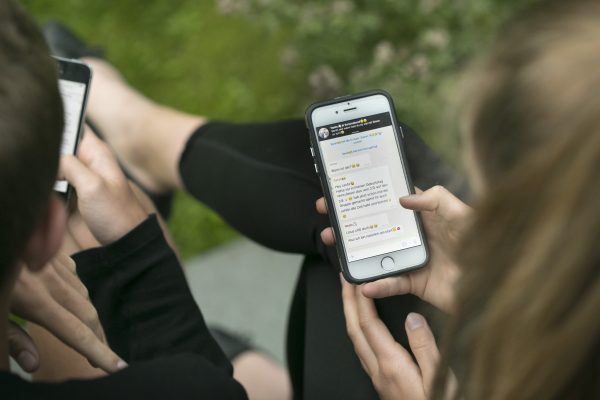
Copyright: Ute Grabowsky/photothek.net
The popularity of messengers is simply due to the widespread use of the service. The apps are often free, and with an Internet flat rate or Wi-Fi access, there are no additional costs. Of course, they also entail risks. If you are concerned about the security of your data or that of your children, just compare the terms and conditions of individual messengers. What happens to the data there? Is the communication encrypted? Are there secure messengers? In the terms of use of many messengers, an age of 13 or even 16 is required for registration. If your child is younger, you must consent to its use.
Through the social web, there are also other numerous ways to participate in the world and stay in touch with others with little effort, such as Instagram and TikTok. Whereby young people do (and can) distinguish between the more public communication via platforms like Instagram and the more or less private exchange. With the smartphone, this happens at any time in any place and, above all, in very different ways.
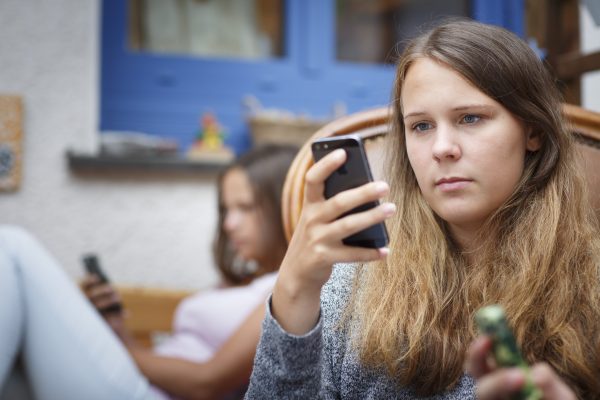
Copyright: Ute Grabowsky/photothek.net
By the time he or she enters secondary school, at the latest, your child will probably have one, too. The smartphone plays a major role among children and young people. Whether through Messenger, the YouTube app, the music player, the navigation app or Instagram: The smartphone is an important part of their everyday lives. At the same time, it is felt almost like a part of one’s own person. Without a smartphone, many young people do not fill completely.
Apps, functions and accessories can personalize and individualize the smartphone and turn it into a status symbol. Different aspects, such as cell phone cover, wallpaper or make of the cell phone are supposed to show that one is up-to-date or particularly cool. This is not a new phenomenon. In the past, clothing or music served as a means of self-expression and demarcation. A special feature of the smartphone is that very personal experiences are documented and stored. The young people have their smartphone all to themselves. And it makes it possible to store intimate things, whether love messages in WhatsApp or photos for self-expression on Insta.
The smartphone has also given rise to a new form of communication among young people that adults can’t always comprehend. Chatting with friends while checking messages is not uncommon and is not necessarily considered rude. At the same time, the smartphone promotes risks such as cyberbullying and sexting, as offline and offline worlds merge.
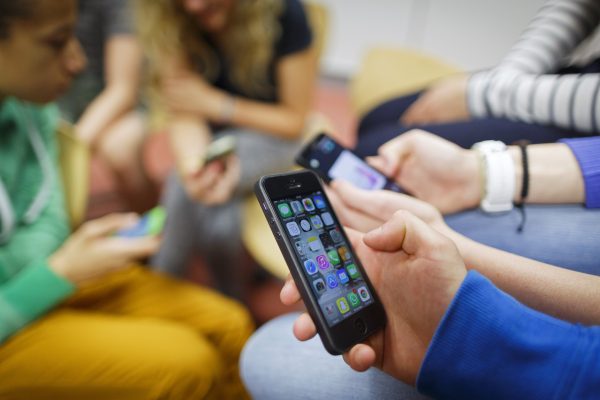
Copyright: photothek.de
More and more children of primary school age, at the latest from around 10 years of age, also have their own smartphone. When they enter secondary school, they are thus available to their parents at all times. At the same time, the desire for independence is on the rise. With your own cell phone, you are no longer dependent on mom or dad’s device, but can usually decide for yourself when to communicate with whom or play the mobile game. However, this harbors potential for conflict and the negotiation of rules becomes necessary.
Digital – especially mobile – media play a major role in communication. Sharing with each other, sharing yourself and testing everything out is important for teenagers. In communication with each other, i.e. with peers, common experiences, adventures and conflicts are shared and reflected upon. Situations from everyday life, such as the bad grade, stress at home or the common crush are occasions for communication – especially away from the adult world.

Copyright. photothek.de
This contributes to the ability to resolve conflicts without parental support, to form one’s own opinion and to defend it. Last but not least, this also serves to actively differentiate the company from other groups. So a new form of independence is also being lived out in digital media.
It may be that your child’s communication sometimes seems cryptic and incomprehensible to you. Do you remember youth language when you were a teenager? Emojis, abbreviations and your own secret words create a protected communication in which teenagers confide in each other. Last but not least, this also serves to actively differentiate the company from other groups.
Digital media are an important part of young people’s everyday culture. There is hardly any separation between offline and online. Especially through mobile media such as the smartphone, these worlds are merging. In the familiar and newly created free spaces, young people try things out, make new friends, develop and share interests. Communication and friendship in everyday life is not replaced, but expanded.

Copyright: photothek.de
Today, it is easier than ever to publish your own opinions and self-designed content. Whether on fashion blogs, gaming sites or YouTube – young people can try out digital spaces and test out how they come across. You can find like-minded people across spatial and social boundaries. Their use of media is fast-moving and their fascination with certain offerings is not always easy to understand: what is exciting today may be boring tomorrow. Interest also depends on what other peers think is great. In addition to hip apps and certain music, the latest series on Netflix is one of them.
For you as a parent, it is particularly difficult to muster understanding when, for example, depictions of violence, horror and splatter films or soft porn are consumed on the net. Much of the content is not always age-appropriate and difficult for young people to assess in terms of its impact. But they want to test their limits. In their digital spaces, the boundaries can be very diverse. In addition to watching certain movies, this can also be contacting people you don’t know. If, for example, contact with the unknown person suddenly becomes unpleasant or the intimate photo suddenly circulates among friends, this can have serious consequences.
It is a difficult task for you as parents to find the right way here. Protect your children from potential dangers, but also encourage autonomous and creative use of digital media.
Communicating online, exchanging ideas and being connected are typical features of the Internet. This interactive site is also discovered early by elementary school children. They like to watch videos – especially via YouTube. Music videos, funny videos and animal videos are especially popular. Only a few children of this age also want to post their own videos. However, sharing with friends about the content you’ve seen is very important.
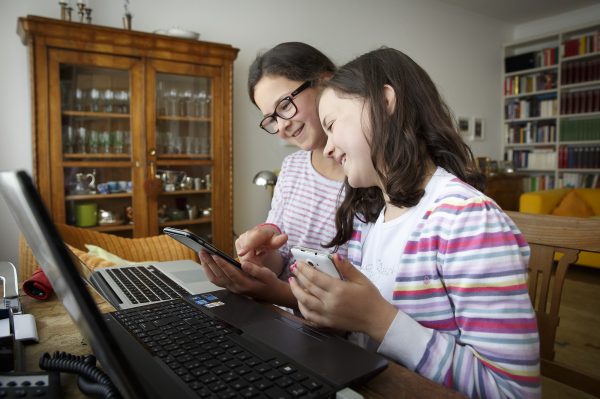
Copyright: Ute Grabowsky/photothek.net
Besides watching videos, the most important online activity is researching. Elementary school children like to search for information online a lot. Mostly people are looking for information for school or music info. Special Internet sites for children are also used for this purpose.
Games on the net are also a big topic. Many children spend time playing online games, preferably together with friends.
After picture books and TV, mobile devices such as smartphones and tablets are among the first media that children get to know. After all, they are present in their lives from the beginning because mom, dad, big sister, grandpa and dad’s girlfriend are constantly holding them. The importance of these devices is not lost on the little ones. Plus, they glow so beautifully and make noise. This also fascinates young children. After all, they are quickly turned on and easy to use. You don’t have to be able to read, but can start a small program very quickly via the icons. And then you can easily take such a device with you to the cozy corner or in the car.
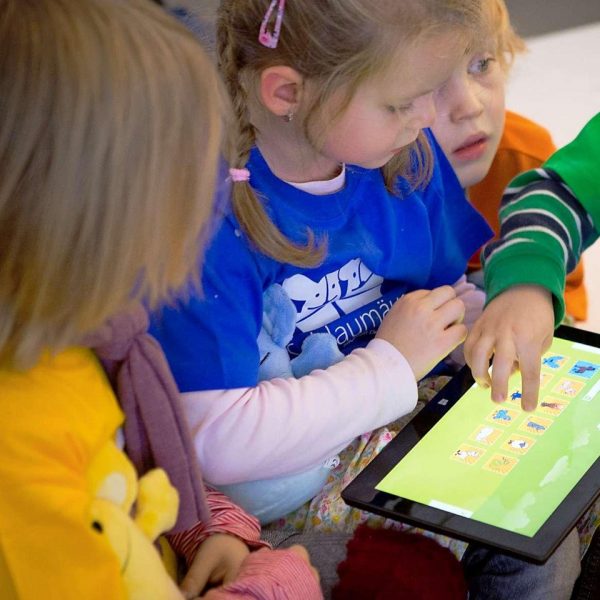
© photothek.net
The fine motor skills of young children are not yet fully developed. Hands and fingers are clumsy and hand-eye coordination is just developing. Operating a tablet is much easier for them than using a keyboard and mouse. But before they are about 18 months old, the little ones can not actively do anything with it. However, tablets can already serve as a digital read-aloud book that you read from.
The linking of different senses is promoted within appropriate children’s activities. From the age of about five, for example, children can acquire important motor and mental skills in online games. Especially for small children, there are many offers on the Internet that limit access to content on the Internet and thus usually do not allow unprotected surfing. Make sure the content of such offerings is appropriate for your child’s developmental level and age.